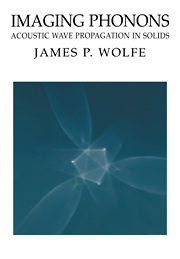Book contents
- Frontmatter
- Contents
- Preface
- Prologue – Anisotropic heat flow in crystals
- 1 Ballistic heat pulses and phonon imaging – A first look
- 2 Phonon focusing
- 3 Generation and detection of phonons – Experimental aspects
- 4 Focusing in cubic crystals
- 5 Acoustic symmetry and piezoelectricity
- 6 Lattice dynamics
- 7 Imaging of dispersive phonons
- 8 Phonon dynamics
- 9 Bulk scattering of phonons – Experiments
- 10 Quasidiffusion and the phonon source
- 11 Phonon scattering at interfaces
- 12 Refraction and reflection at solid/solid interfaces – Experiment
- 13 Imaging ultrasound in solids
- 14 Imaging surface acoustic waves
- 15 Interactions of ballistic phonons with electrons
- Appendix I Algebraic solution to the wave equation
- Appendix II Abbreviated tensor notation and group velocity
- Appendix III Survey of phonon focusing in cubic crystals
- Index
9 - Bulk scattering of phonons – Experiments
Published online by Cambridge University Press: 24 March 2010
- Frontmatter
- Contents
- Preface
- Prologue – Anisotropic heat flow in crystals
- 1 Ballistic heat pulses and phonon imaging – A first look
- 2 Phonon focusing
- 3 Generation and detection of phonons – Experimental aspects
- 4 Focusing in cubic crystals
- 5 Acoustic symmetry and piezoelectricity
- 6 Lattice dynamics
- 7 Imaging of dispersive phonons
- 8 Phonon dynamics
- 9 Bulk scattering of phonons – Experiments
- 10 Quasidiffusion and the phonon source
- 11 Phonon scattering at interfaces
- 12 Refraction and reflection at solid/solid interfaces – Experiment
- 13 Imaging ultrasound in solids
- 14 Imaging surface acoustic waves
- 15 Interactions of ballistic phonons with electrons
- Appendix I Algebraic solution to the wave equation
- Appendix II Abbreviated tensor notation and group velocity
- Appendix III Survey of phonon focusing in cubic crystals
- Index
Summary
Phonon scattering and thermal conduction
We have seen that the mean free path of high-frequency phonons is greatly limited by scattering in the bulk of the crystal. The experiments discussed in Chapter 7 were concerned with the relatively small fraction of large-k phonons that traverse the crystal ballistically as identified by their sharp focusing pattern. In those experiments, the bulk scattering of high-frequency phonons by mass defects acted as a low-pass filter, which, in combination with a high-pass detector, provided an effective means of frequency selection for the ballistic phonons. In Chapter 8, we developed a theoretical basis for phonon scattering. Now we will describe experiments that measure the phonon scattering processes in detail.
There are several different phonon-scattering processes to be considered. As discussed in Chapter 8, the simplest form of scattering is from atomic mass defects that differ from their neighbors only in isotopic mass. Because most atoms occur naturally with several isotopic masses, this type of defect is ubiquitous. Only a few crystals, such as NaF, occur naturally in an isotopically pure form. Because the natural isotopic abundance of atoms is generally well known, however, phonon scattering from randomly occurring isotopes (i.e., isotope scattering) is very predictable and serves as an important test case for phonon-scattering theories.
Another common form of defect scattering occurs when an impurity atom substitutes for a host atom in the crystal.
- Type
- Chapter
- Information
- Imaging PhononsAcoustic Wave Propagation in Solids, pp. 213 - 243Publisher: Cambridge University PressPrint publication year: 1998



